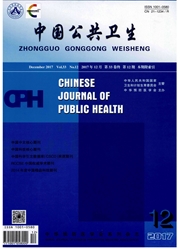

 中文摘要:
中文摘要:
目的 探索蜡样芽孢杆菌Cr4-1对六价铬[Cr(VI)]的还原特性。方法 采用正交试验研究温度、p H、初始Cr(VI)浓度、摇床转速对细菌生长和Cr(VI)还原的影响;使用9种常见碳源进行细菌生长和Cr(VI)还原试验,筛选最佳碳源和电子供体;采用透射电子显微镜观察不同浓度Cr(VI)还原细菌,细菌前后形态的变化。结果 影响该细菌生长的主要因素是摇床转速和p H值,影响Cr(VI)还原细菌的主要因素是初始Cr(VI)浓度和温度。细菌生长和Cr(VI)还原的较优条件是温度35℃、p H=9、初始Cr(VI)浓度为30 mg/L、转速150 r/min。乳酸钠是细菌生长和Cr(VI)还原的较好碳源,其次是丙酮酸钠。透射电镜观察发现,初始Cr(VI)浓度为30 mg/L和60 mg/L时,还原过程中Cr(VI)对细菌具有毒性作用,浓度越高,细菌损伤越严重。结论 蜡样芽孢杆菌Cr4-1对Cr(VI)的还原效果明显,具有较好的应用前景。
 英文摘要:
英文摘要:
Objective To study the reduction of hexavalent chromium (Cr[Ⅵ] ) by Bacillus cereus (B. cereus) Cr4-1. Methods Effects of temperature,pH,initial Cr(Ⅵ) concentration and shaker speed on hexavalent chromium reduction and the growth of B. cereus were explored with orthogonal tests. Nine common carbon sources were used in the bacteria culture and Cr(Ⅵ) reduction test in order to screen the optimum carbon source and electron donor. Transmission electron microscopy was employed to observe morphological changes of bacteria Cr4-1 before and after Cr (Ⅵ) reduction. Results The main factors influencing the growth of the bacteria were shaking speed and pH value. The main factors influencing the Cr(Ⅵ) reduction were initial Cr(Ⅵ) concentration and temperature. The better conditions for the bacterial growth and Cr(Ⅵ) reduction were the temperature of 35℃, pH value of 9, initial Cr(Ⅵ) concentration of 30mg/L, and the shaking speed of 150 r/min. Sodium lactate was the best carbon source for bacterial growth and Cr(Ⅵ) reduction, followed by sodium pyruvate. Toxic effect of Cr(Ⅵ) on B. cereus Cr4-1 strain during Cr(Ⅵ)reduction process at the initial Cr(Ⅵ) concentration of 30 and 60 mg/L was observed with transmission electron microscope and the effect was positively correlated with the initial Cr (Ⅵ)concentration. Conclusion Bacillus cereus Cr4-1 presents good efficiency in bioreduction of hexavalent chromium and could be used in practical application.
 同期刊论文项目
同期刊论文项目
 同项目期刊论文
同项目期刊论文
 期刊信息
期刊信息
